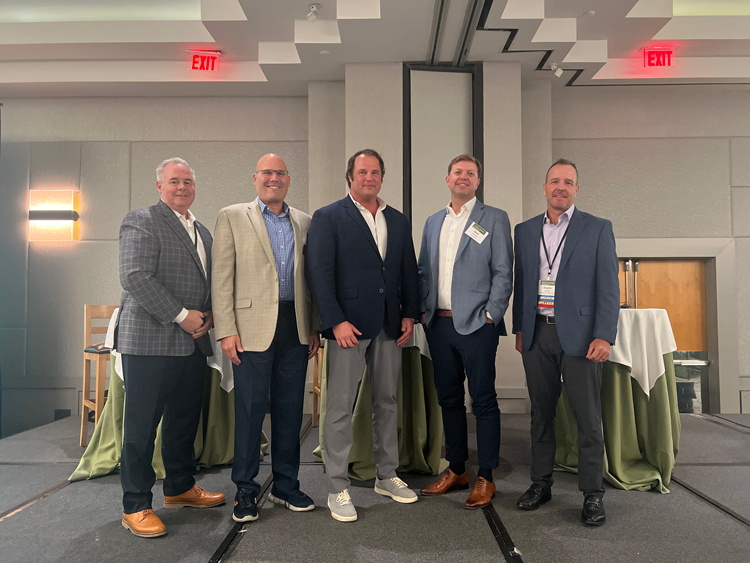By Matt Valley
Heading into 2023, Lument’s Aaron Becker anticipated a challenging year for lenders and borrowers due to the sharp rise in interest rates, but he underestimated the level of difficulty. Capital providers tightened underwriting standards more than expected, which negatively impacted deal volume.
U.S. property and portfolio sales in the seniors housing sector, excluding skilled nursing, totaled $3.27 billion during the first half of 2023 compared with $4.57 billion during the same period in 2022, according to MSCI Real Assets.
That’s a 28 percent decline in deal volume year over year. The data is based on transactions $2.5 million and above.
Unexpected ‘body blow’
Rising property insurance premiums have compounded the underwriting challenges.
The average U.S. quarterly insurance premium per apartment unit in June was 33 percent higher than a year earlier, according to Marcus & Millichap. Insurance now accounts for more than 8 percent of an owner’s quarterly operating expenses per unit, nearly double the share from five years ago.
Becker believed Federal Reserve Chairman Jerome Powell when he warned that interest rates could stay elevated for an extended period to fight inflation.
“I never thought that rates were going to be cut this year. I was expecting a tough year, but I’d say it’s been even tougher than I thought. Issues on the expense side, especially the insurance… I wasn’t expecting to get another body blow on that from an underwriting standpoint,” said Becker, senior managing director and head of seniors housing at Lument.
In response to the higher interest rates, loan assumptions are on the rise, according to Becker. A loan assumption enables a buyer to take over the current owner’s mortgage while the loan terms remain the same, including the repayment period and interest rate.
“A lot of sponsors are taking advantage of assumable loans that were underwritten in a very different market than we’re in today.”
The comments from Becker came during a capital markets panel discussion at InterFace Seniors Housing Southeast. The 10th annual conference took place Aug. 16 at the Westin Buckhead Atlanta. France Media’s InterFace Conference Group and Seniors Housing Business hosted the event, which drew 369 industry professionals.
Christopher Honn, managing director of seniors housing originations at NewPoint Real Estate Capital, moderated the capital markets panel discussion.
The other three industry experts on the five-member panel included Chad Borst, senior vice president and senior loan officer at Live Oak Bank; Dave Harper, senior vice president of Capital One Healthcare Real Estate; and Charlie Shoop, senior vice president of healthcare for KeyBank Real Estate Capital.
Harper said the ability of seniors housing operators to pass along annual rental rate increases of 8 to 10 percent to residents is what has surprised him the most thus far this year. He’s encouraged by the industry’s improving vital signs. Labor costs are moderating, while the performance of the industry has rebounded faster than expected in the wake of the COVID-19 pandemic.
Unfortunately, interest rates have negated those improvements, Harper lamented. The Fed has raised the federal funds rate from 0.25 percent in early 2022 to 5.5 percent today. The secured overnight financing rate (SOFR) has risen from 0.05 percent to 5.3 percent over the same period.
“Hopefully, those rate increases are temporary. But if we can get SOFR back down to 2.5 or 3 percent as a normalized rate, things are going to look a lot better,” said Harper. “This industry has been resilient and shown the ability to adapt, and there are a lot of tailwinds.”
Is surge in rental rates sustainable?
Honn pointed out that his dad has resided in an assisted living community for nearly four years, and that his father’s apartment rent increased 8 percent this year. “I’ve been in this industry so long (more than 35 years). In the past, if you could get an 8 percent rate increase, you’d have a big celebration and party for a week because it was so unheard of, right?”
Honn asked the panelists if the hefty rental rate increases that operators are successfully pushing through now are sustainable, and what their approach is to underwriting rents.
It’s going to vary by market, explained Harper. “If you’re in a high-barrier-to-entry market with limited supply, you can probably underwrite [healthy] rental increases going forward. But if you’re in a market where there’s a lot of supply, it’s hard to justify that.”
It helps that Social Security beneficiaries received an 8.7 percent increase in their benefits in 2023 — the highest increase in 40 years — to combat soaring inflation. The cost-of-living adjustment amounted to an increase of approximately $140 per month.
The big bump in rental rates made sense in 2023 because of the well-chronicled economic problems triggered by high inflation, said Becker. The Consumer Price Index rose 6.5 percent on an annual basis in December 2022.
“A lot of the residents still collect a Social Security check whether they need it or not, and they received a big bump this year,” explained Becker. “They’re not going to get a 9 percent bump next year in Social Security. It’s going to be a different mindset, and it’s going to be much more difficult, generally speaking, to pass along rent increases like that going forward.”
The rising-interest-rate environment has created an opportunity in the marketplace for Live Oak Bank, which has a bridge-to-agency loan platform, explained Borst. For example, a borrower that doesn’t currently qualify for a permanent loan through Fannie Mae, Freddie Mac or HUD either because the net operating income generated by the asset is insufficient or because interest rates are too high can seek a short-term bridge loan. When market conditions improve, the borrower can replace the bridge loan with a permanent loan through the agencies.
Because operators face myriad and significant cost pressures today, Borst says Live Oak Bank seeks strong sponsors that can “weather that storm.”

